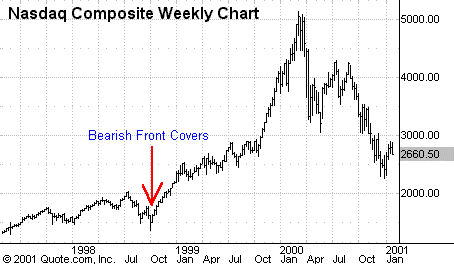Sentiment Indicators I Could Not Live Without
This is a
follow-up to an earlier piece about some of the sentiment indicators that I
watch. These are contrarian indicators, meaning if they flash
too much bearishness, it may be time to go the other
way. Now it is imperative to remember that regardless of
these indicators, for me, market action will always take center
stage. Sentiment is
secondary to my work but has to be watched especially when the numbers hit
extremes. I will start getting real excited with powerful stock market action.
What have some of these indicators flashed recently?
Front Cover
Indicator: Back at the ’98 lows, Newsweek, Time,
Fortune, Forbes and even Esquire
had front covers depicting crashes and bears. Of course, this happened
after the drop. These magazines are notorious in reporting the news loudly after
the move has already been made. Pictures of bears and declining charts in Newsweek, Time,
U.S. News, and The Economist get me wondering: Could they have called the low
for the cycle again? Hmm…


Put/Call
Ratio: During good times, people are optimistic. In such times, more often than
not, investors are buying
calls…betting on higher prices. But what happens when
investors are panicky? They buy
puts. When
the ratio of trading volume in puts vs. calls hits above 1.0, it is
considered extreme pessimism and can possibly signal a turn in the market in the near-term.
Put/Call
Ratios can spike to extreme numbers on really bad days as investors bet on lower
prices after
the drop. Hmm…another notch in the
bull’s belt.
VIX/VXN: You may have seen my occassional
references to certain volatility
measurements. These
two numbers can also go to extremes during panic days. In layman’s terms,
they
measure the tone of the selling, which, to say the least, can get panicky at the
lows. The VIX on such occasions can move above 40,a number believed to be
extreme. When the VXN moves above 80, I would say the VXN as a contrary
indicator has turned green.
ARMS Index: Many people call this the
“perfect indicator” because it so rarely signals, and only with extremes. An extreme
number of 1.5 has only been hit on several occasions. The last few — Sept. 3,
1981; Aug. 2, 1982; Oct. 16, 1987; Nov. 30, 1987; Oct. 27, 1987; and (drum roll,
please) March 16, 2001. I use this as
another measurement of panic and volatility in looking for the lows.
The things you hear every day: Yes, this is one of my
favorites. Back at the lows
in 98,I was listening to rumors of Banker’s Trust and Lehman Brothers filing
bankruptcy. I was listening to the supposed destruction of the finance system
because of a hedge fund. Russia and Mexico imploding. Get the hint. Think about
what kind of talk you have heard at tops. Conversely, what have you heard at
lows? Depression, recession, the next
Japan, layoffs, bankruptcies, analyst downgrades, lowered estimates, no
visibility, stagflation. I don’t remember ever hearing this type of talk at the
highs, only the lows.
All in all, just some more ammunition for your
investing. When sentiment numbers
go to extremes, it is like an alarm bell for
me.
Here For A Free 1-Week Trial To Gary Kaltbaum’s Intra-Day Alerts Service
